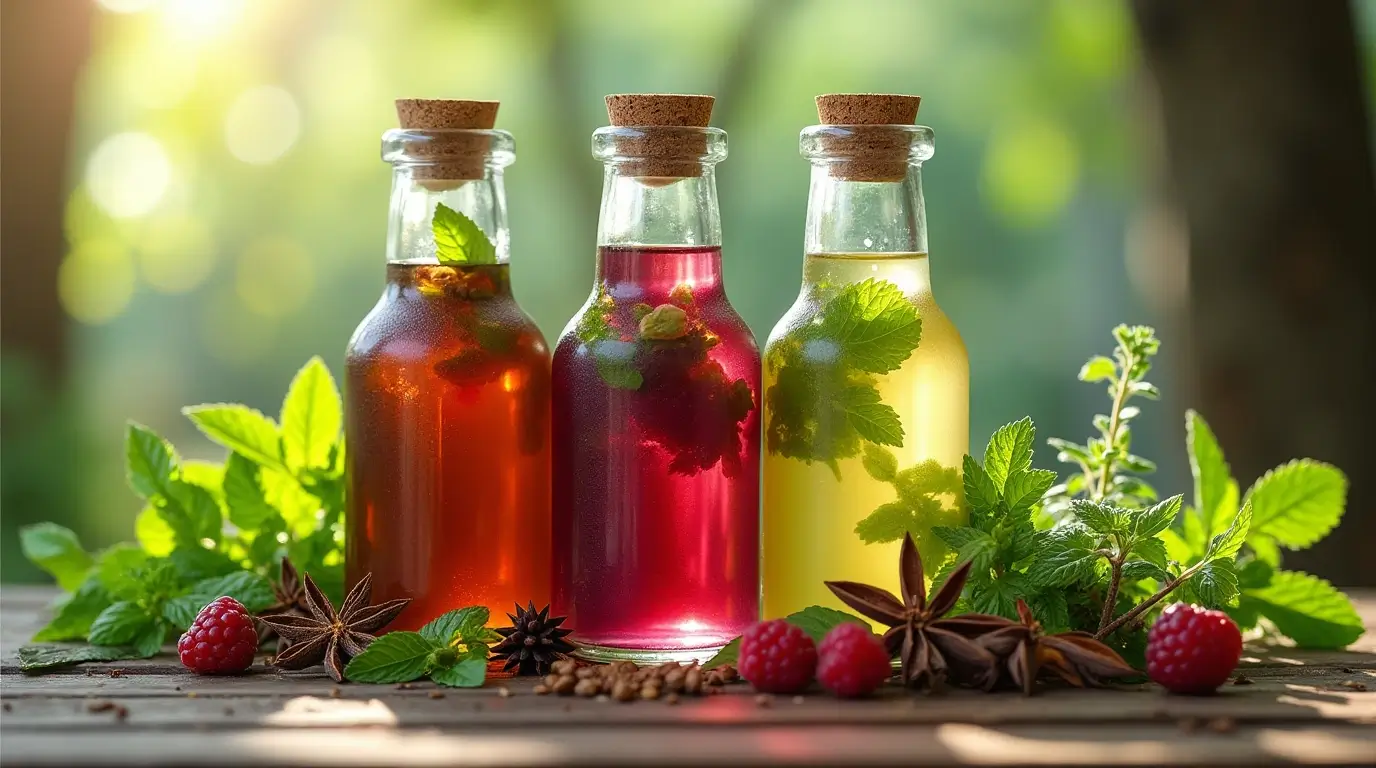Table of Contents
Imagine crafting a vibrant, flavorful elixir that’s both delicious and beneficial for your well-being, using herbs from your own garden or local market. This isn’t just a fantasy—it’s the reality of making your own herbal cordial at home. Whether you’re a seasoned herbalist or a curious beginner, creating your own herbal cordial recipe opens up a world of botanical flavors and potential wellness benefits.
Herbal cordials are concentrated sweetened herbal extracts, typically made with alcohol, that capture the essence, flavor, and beneficial properties of herbs. Unlike liqueurs (which are often commercial and heavily sweetened), syrups (which are sugar-based without alcohol), or tinctures (which are medicinal and unsweetened), cordials strike a perfect balance between flavor and function.
These botanical concoctions have a rich history dating back centuries, when they were originally created for medicinal purposes. Monks, herbalists, and healers would infuse local herbs in alcohol to preserve their medicinal properties, adding honey or sugar to make them more palatable. Today, we continue this time-honored tradition, though often with more focus on the culinary delights they offer alongside their wellness benefits.
By making your own herbal cordial recipe at home, you gain complete control over ingredients, flavor profiles, and sweetness levels—something you simply can’t achieve with store-bought alternatives.
Why Make Herbal Cordials? The Benefits of Homemade Herbal Cordial Recipes
Explore a Universe of Flavors
One of the most compelling reasons to create your own homemade herbal cordial recipe is the incredible diversity of flavors you can achieve. From the bright, citrusy notes of lemon balm to the deep, earthy warmth of cinnamon and cardamom, the flavor combinations are virtually endless. You can create seasonal blends that celebrate what’s currently growing, or design signature cordials that become your personal trademark.
Potential Wellness Benefits
Many herbs traditionally used in cordials contain compounds that may offer health benefits. For instance:
- Elderberry contains antioxidants and has been studied for its immune-supporting properties
- Lemon balm has traditionally been used to support relaxation and digestion
- Ginger has well-documented anti-inflammatory properties and aids digestion
While these potential benefits are supported by some research, it’s important to note that cordials should be enjoyed as part of a balanced lifestyle rather than as medicine. Always consult with healthcare professionals regarding specific health concerns.
Customize to Your Preferences
When following an easy herbal cordial recipe, you have complete freedom to adjust every element:
- Sweetness level: From barely-there to dessert-like
- Alcohol content: High-proof for preservation or lower for everyday enjoyment
- Herb combinations: Create unique blends that aren’t available commercially
- Intensity: Control the strength of herbal flavors through infusion time
Sustainability and Connection
Creating cordials connects you with seasonal rhythms and local plant life. By using herbs you’ve grown yourself or sourced locally, you reduce packaging waste and transportation emissions associated with commercial products. There’s something deeply satisfying about transforming plants from your garden into concentrated elixirs that can be enjoyed throughout the year.
Essential Ingredients & Equipment for Your Homemade Herbal Cordial Recipe
Herbs: The Heart of Your Cordial
The herbs you select will define your cordial’s character. Here’s a guide to help you choose:
| Herb Category | Examples | Flavor Profile | Traditional Uses |
|---|---|---|---|
| Aromatic | Lavender, rosemary, thyme | Fragrant, complex | Relaxation, respiratory support |
| Citrusy | Lemon verbena, lemon balm, lemongrass | Bright, uplifting | Mood enhancement, digestion |
| Warming | Cinnamon, ginger, cardamom | Spicy, comforting | Circulation, digestion |
| Fruity | Elderberry, blackberry leaf, hibiscus | Sweet, tart | Immune support, vitamin C |
| Floral | Rose, chamomile, elderflower | Delicate, aromatic | Relaxation, skin health |
When selecting herbs, prioritize quality. Organic, freshly dried herbs will yield the most flavorful and beneficial cordials. If using fresh herbs, you’ll generally need twice the amount compared to dried.
Alcohol: The Extracting Medium
The alcohol you choose affects both flavor and extraction efficiency:
- Vodka (40% ABV/80 proof): Neutral flavor that lets herbs shine
- Brandy (35-60% ABV/70-120 proof): Adds fruity warmth and complexity
- Gin (40-47% ABV/80-94 proof): Complements botanical flavors with its own herbal notes
- Everclear or high-proof grain alcohol (75-95% ABV/150-190 proof): Maximum extraction but requires dilution
For those avoiding alcohol, alternatives include:
- Food-grade vegetable glycerin
- Apple cider vinegar (creates an “oxymel” rather than a true cordial)
- Strong tea bases (shorter shelf life)
Sweeteners: Balancing the Flavor
Your sweetener choice contributes significantly to the final flavor profile:
- Honey: Adds complexity and potential antimicrobial properties
- Sugar: Clean sweetness without competing flavors
- Maple syrup: Rich, caramel notes that pair well with warming herbs
- Agave nectar: Neutral sweetness with low glycemic impact
Essential Equipment
To create your cordial, you’ll need:
- Glass jars with tight-fitting lids for infusion (Mason jars work perfectly)
- Fine mesh strainers for initial filtering
- Cheesecloth or coffee filters for secondary filtering
- Funnel for transferring liquid without spills
- Dark glass bottles for storage (amber or cobalt help protect from light degradation)
- Labels for tracking creation date and ingredients
- Measuring cups and kitchen scale for consistent recipes
The Cordial-Making Process: Step-by-Step Easy Herbal Cordial Recipe
Infusion Methods

There are several approaches to infusing herbs into alcohol, each with advantages:
- Cold Infusion (Most Common)
- Place dried herbs in a clean glass jar
- Cover completely with alcohol, leaving 1-inch headspace
- Seal tightly and store in a cool, dark place
- Shake daily for 2-6 weeks
- Strain and sweeten
- Warm Infusion (Faster Option)
- Place herbs and alcohol in a glass jar
- Set jar in a water bath at low heat (below 170°F/77°C to preserve alcohol)
- Maintain warm temperature for 2-3 hours
- Cool, then continue steeping for 3-5 days
- Strain and sweeten
- Percolation (Advanced Technique)
- Pack herbs into a percolation cone or adapted French press
- Slowly drip alcohol through the herb pack
- Results in stronger extraction in less time
- Requires special equipment and practice
Infusion Time Considerations
The optimal infusion time depends on several factors:
- Herb type: Delicate herbs (flowers, leaves) require shorter infusion (2-3 weeks); tough plant materials (roots, berries) need longer (4-6 weeks)
- Alcohol strength: Higher proof extracts faster
- Particle size: Finely cut herbs infuse more quickly than whole
- Temperature: Warmer environments speed up extraction (but may reduce quality)
A good rule of thumb: When the color and aroma have fully transferred to the alcohol, it’s ready to strain.
Straining & Filtering for Clarity
For a pristine final product:
- First strain through a fine-mesh sieve to remove large plant material
- Then strain through dampened cheesecloth or coffee filters for clarity
- For exceptional clarity, refrigerate overnight and strain again (cold temperature precipitates some compounds)
- Be patient—rushing the filtering process results in cloudy cordials
Sweetening & Adjusting Your Homemade Herbal Cordial Recipe
This step transforms your herbal infusion into a true cordial:
- Make a simple syrup by dissolving equal parts sugar and water (or use honey, etc.)
- Start by adding 1 part simple syrup to 3 parts infusion
- Taste and adjust sweetness gradually
- Allow the sweetened cordial to rest for 1-2 days before final adjustments
- Consider adding complementary elements:
- A few drops of tincture for enhanced properties
- Citrus zest for brightness
- Vanilla for depth
Bottling & Storage
Proper storage ensures your cordial maintains quality:
- Sterilize bottles by boiling or with a food-safe sanitizer
- Fill bottles using a funnel, leaving minimal headspace
- Seal tightly with corks or caps
- Label with contents and creation date
- Store in a cool, dark place
- Most cordials maintain quality for 1-2 years, though higher alcohol content preserves longer
Troubleshooting & FAQs for Your Easy Herbal Cordial Recipe
Common Issues
- Cloudy cordial: Caused by insufficient filtering or temperature changes. Solution: Re-filter through coffee filters after refrigerating overnight.
- Off flavors: Usually from using low-quality alcohol or over-extracting. Solution: Use better alcohol and adhere to recommended infusion times.
- Separation: Can occur with high-oil content herbs. Solution: Shake before using or filter through a fat separator.
- Weak flavor: Typically from insufficient herb quantity or premature straining. Solution: Use 1:5 ratio (herb to alcohol by weight) and ensure adequate infusion time.
Frequently Asked Questions
Q: How long will my herbal cordial last?
A: Properly made cordials with at least 20% alcohol content typically last 1-2 years when stored in a cool, dark place. Higher alcohol content cordials can last even longer.
Q: How much should I consume?
A: Cordials are concentrated and should be enjoyed in small amounts—typically 1-2 tablespoons (15-30ml) at a time, diluted or straight.
Q: Can I mix herbs in my herbal cordial recipe?
A: Absolutely! Some of the most interesting cordials combine complementary herbs. Start with established combinations like mint and lemon balm before experimenting more widely.
Q: Is my cordial alcoholic?
A: Yes, traditional cordials contain alcohol. The final alcohol percentage depends on your base alcohol and how much sweetener you add. A cordial made with 40% vodka and 25% simple syrup ends up around 30% alcohol.
Safety Considerations When Making Herbal Cordials
Herb Identification and Selection
The most important safety consideration is proper herb identification:
- Never use wildcrafted herbs unless you are 100% certain of identification
- Purchase herbs from reputable suppliers
- Research herbs thoroughly before using in cordials
- Avoid toxic look-alikes (like poison hemlock, which resembles parsley)
Potential Interactions
Herbs can interact with medications and medical conditions:
- Many herbs (like St. John’s Wort) can interact with prescription medications
- Some herbs may not be suitable during pregnancy or breastfeeding
- Certain herbs may affect blood pressure, blood sugar, or other health factors
Important: Before consuming herbal cordials regularly, especially if you have medical conditions or take medications, consult with a qualified healthcare professional. This is particularly important for pregnant or nursing women, those with chronic health conditions, or people taking prescription medications.
Alcohol Considerations
Remember that cordials contain alcohol:
- Not appropriate for those avoiding alcohol for health, religious, or recovery reasons
- Not suitable for children
- Should be consumed responsibly and in moderation
Conclusion: The Joy of Creating Your Own Herbal Cordial Recipe

Crafting your own herbal cordials connects you to an ancient tradition while allowing for modern creativity and personalization. With just a handful of quality ingredients and a bit of patience, you can create sophisticated botanical elixirs that reflect your taste preferences and the seasonal bounty of herbs.
Whether you’re creating a warming elderberry cordial to enjoy during winter months, a refreshing mint and lemon balm blend for summer cocktails, or a special rose and cardamom cordial as a unique gift, the process is both rewarding and delicious.
The world of homemade herbal cordial recipes offers endless possibilities for exploration. Start with simple combinations of familiar herbs, then gradually expand your repertoire as your confidence grows. Before long, you’ll have a collection of signature cordials that express your unique herbal style.
Ready to begin your cordial-making journey? Subscribe to our newsletter for seasonal recipes, herb spotlights, and exclusive tips from experienced herbalists. And when you create your first homemade herbal cordial recipe, share a photo on social media and tag us—we’d love to see your creations!
Remember: The true magic of cordial-making lies not just in the final product, but in the mindful process of working with herbs and creating something uniquely yours.

